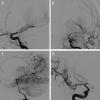A case with unusual stroke and fulminant outcome in a Hispanic male
- PMID: 24167642
- PMCID: PMC3808186
- DOI: 10.12659/AJCR.889590
A case with unusual stroke and fulminant outcome in a Hispanic male
Abstract
Patient: Male, 42 FINAL DIAGNOSIS: Moyamoya disease (MMD) Symptoms: Aphasia • concentration difficulty • dysarthria • personality change
Medication: - Clinical Procedure: - Specialty: Radiology.
Objective: Rare disease.
Background: Moyamoya disease (MMD) was first described in 1957 as "hypoplasia of the bilateral internal carotid arteries." The characteristic appearance of the associated network of abnormally dilated collateral vessels on angiography was later likened to "something hazy, like a puff of cigarette smoke," which, in Japanese, is Moyamoya. This paper describes the fulminant course of the disease in a Hispanic male involving the corpus callosum.
Case report: A 42-year-old Hispanic male with progressive aphasia, slow mentation, and sudden onset of sensorimotor symptoms with gait disturbance was found to have multiple intracranial supratentorial infarcts of variable stages of evolution involving, but not limited to, the anterior corpus callosum, followed by rapid development of further infarcts. Angiography demonstrated right ACA occlusion, left supraclinoid ICA occlusion with a Moyamoya pattern of collateralization, and diffuse arteriopathy. A fulminant course ensued and the patient did not survive the acute phase of ischemic disease.
Conclusions: Moyamoya disease may rarely present in North American Hispanic males, with advanced atypical clinical and imaging features involving the anterior corpus callosum and having a fulminant course.
Keywords: corpus callosum; infarction; moya moya disease.
Figures


References
-
- Derdeyn CP. Moyamoya disease and moyamoya syndrome. N Engl J Med. 2009;361(1):97. author reply 98. - PubMed
-
- Hallemeier CL, Rich KM, Grubb RL, Jr, et al. Clinical features and outcome in North American adults with moyamoya phenomenon. Stroke. 2006;37(6):1490–96. - PubMed
-
- Miyatake S, Miyake N, Touho H, et al. Homozygous c.14576G>A variant of RNF213 predicts early-onset and severe form of moyamoya disease. Neurology. 2012;78:803. - PubMed
-
- Yamauchi T, Tada M, Houkin K, et al. Linkage of familial moyamoya disease (spontaneous occlusion of the circle of Willis) to chromosome 17q25. Stroke. 2000;31:930. - PubMed
-
- Mineharu Y, Liu W, Inoue K, et al. Autosomal dominant moyamoya disease maps to chromosome 17q25.3. Neurology. 2008;70:2357. - PubMed
LinkOut - more resources
Full Text Sources
Other Literature Sources
Miscellaneous
